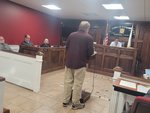
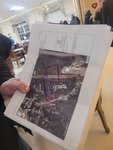

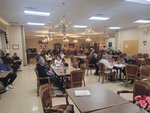
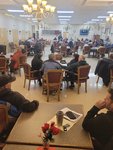



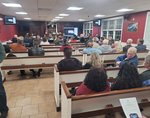
As kids, Wayne J. Forrest, his brothers and friends, held bike races up and down Winsor Avenue.
“To say there’s been a lot of changes on Winsor Avenue in 65 years is an understatement,” Forrest told the Johnston Town Council Monday night.
“If a car came by, it was a major event. It was a big deal.”
During the meeting, Forrest was one of four town residents to stand and speak out against five new solar fields proposed for Johnston’s west-end.
“I’m not sure why the town seems to be on this rapid speed to get every square inch of this town developed,” Forrest said. “It’s a beautiful area.”
Forrest lives at 154 Winsor Ave., on the corner of Winsor and Hopkins.
“My folks built that house in 1957, and I lived there until I was 25,” Forrest recalled. “Went off. Got married. Came back four years ago, with my wife, who was kind enough to help me downsize, and carry on my family tradition of living in the house I grew up in.”
Cranston-based Green Development has pitched five master plans for five separate solar fields off Elmgrove Avenue, Harilla Lane and Winsor Avenue.
The Johnston Planning Board voted unanimously to approve the master plans, and the proposals are expected to be heard before the Zoning Board meeting on Thursday, March 31.
The five proposed solar fields would be constructed on mostly wooded plots across approximately 325 acres. Local abutters have been raising concerns about the environment and neighboring property values.
Robert J. Civetti, the Town Councilman representing District 5, has been fielding complaints from his constituents regarding the solar field proposal.
On Monday night, Civetti asked Town Solicitor William J. Conley Jr. whether Town Council could legally enact a moratorium on solar development until planning officials could adequately update the Johnston’s Comprehensive Plan.
“We heard from four residents this evening,” Civetti said. “There is a petition out there … at last check, there are over 219 signatures from residents in the town of Johnston that have signed it, looking for the council to do something. Mr. Conley, you’re the attorney, you can tell us what legally we can do and can’t do, but I would think there’s something that can be done to at least halt it until we can look at it.”
“A moratorium to interfere with another party’s property rights is generally highly disfavored,” Conley replied.
Civetti said that it’s likely only a matter of time before the solar fields earn full approval of both the Planning and Zoning Boards.
“We all know the Zoning Board, it is an approved use,” Civetti said. “So it’s probably going to go to Zoning Board, and once it hits Zoning Board, it will get approved. Because again, it is an allowed use based on a zoning ordinance. But right now, where it’s still at the master plan level, let’s … pump the breaks a little.”
Civetti and neighbors plan to meet with Green Development at one of the sites on March 26.
“I never thought I’d see the day where you’d have … morning rush hour on Winsor Avenue coming from Connecticut to Citizens Bank,” Forrest told Town Council. “And an afternoon rush hour from Citizens Bank back to Connecticut. Winsor Avenue has become a cut-through for people going from Scituate to Greenville, avoiding Route 6, avoiding Route 44.”
Traffic congestion, spurred by massive swaths of development, has become a major concern for Johnston residents.
“I hope the Town Council takes a minute, listens to Mr. Civetti’s proposal to pump the breaks a little bit,” Forrest said. “Let’s take a step back. Let’s take a deep breath. Let’s see what we’re doing up here.”
Resident Lynn Grissom read from “Element 5” of the town’s Comprehensive Plan, which was last updated in 2007.
“Improving the quality of life for local residents by protecting the environment and its natural resources,” she said. “Preserving the historic and archeological sites. Maintaining and improving open space conservation resources. Preserving land in its natural state. And minimizing negative impacts upon the environment during property development.”
She asked town officials to look more closely at efforts in cities like Warwick, where a solar moratorium was enacted, but official development applications had yet to be filed.
“They’re restricting solar development to developed commercial and industrial areas; large parking lots, rooftops, solar canopies and parking lots,” Grissom said. “They’ve done this in Vermont, they’ve done this all over. They’re putting solar canopies on high school parking lots, rather than mowing down trees to develop and throw up these solar arrays.”
A different Rhode Island based company recently announced a rooftop solar project on the rooves of Ocean State Job Lot stores, including the Johnston location. Rooftop solar arrays provide many of the same benefits as solar fields, but make use of unused space and do not require cutting down trees.
Grissom also questioned the health and safety implications of large solar fields in close proximity to homeowners.
“The Rollingwood area where I live would be engulfed in an entire horseshoe of these things,” Grissom said. “Is that safe for our residents? We don’t know. We need a study.”
She asked for help from Town Council.
“Like Warwick, I believe we need the involvement and encouragement of all residents in the formulation, review and adoption or amendment of the Comprehensive Plan,” Grissom urged. “And I ask for your help before we don’t have any of this open land left in the town.”
Town Council President Robert Russo reminded the audience that the proposed solar projects are not under direct consideration by Town Council. The decision will be up to the Planning and Zoning boards — two entities that merely enforce the town’s Comprehensive Plan and zoning ordinances.
The five projects include — a 1.0 Megawatt solar field, called, GD Johnston Elmgrove II, at 25 Elmgrove Ave. (AP 51 Lot 4, zoned R40); GD Johnston Harilla I, a 2.25 MW solar field at 28 Harilla Lane (AP 51 Lots 9 & 11, zoned R40); GD Johnston Winsor I, a 4.0 MW solar field at 46 Winsor Ave. (AP 60 Lot 4, zoned R40); GD Johnston Winsor II, a proposed 8.0 MW solar field at 86 Winsor Ave (AP 60 Lots 2, 20, 86, zoned R20 & R40); and GD Johnston Winsor III, a proposed 24.0 MW solar field at 112 Winsor Ave. (AP 59 Lot 15, zoned R40).
One of the proposed projects, if approved, will be constructed just 200 feet from Chris and Bonnie Dibble’s property line. The proposed access road will be built a mere 50 feet from his house.
“I’m not just worried about NIMBY (Not In My Backyard) type issues,” Chris Dibble told Town Council. “This is bigger. These projects will cut and develop the only large forested areas in town that are not Snake Den or the Amazon site off of Hartford Ave.”
Like many in town, the Dibbles chose their new home based in large part by the property’s surroundings. They said they knew there was some risk of development. They hoped, however, their new neighbors might be young families, rather than industrial solar panels.
“These … forested areas are important to maintaining Johnston’s rural nature and atmosphere,” Chris Dibble said. “They’re important, to health, air quality and animal habitats … That said, it is in the town’s Comprehensive Plan to preserve open forest spaces. The area off Winsor Ave. … was specifically identified as a target for conservation.”
Dibble and Grissom called on town officials to revise the Comprehensive Plan.
“The town’s Comprehensive Plan was last updated in 2007,” Dibble said. “We have been paying attention to the proceedings of this board and the town’s other boards, zoning and planning.”
For years, the town’s governing boards have promised revisions to Johnston’s major planning document.
“The existing plan does not discuss solar governance,” Dibble said. “It wasn’t a major consideration 15 years ago … There are a lot of ways you can interpret a 600 page document.”
Civetti agrees there is language in the current plan that calls for the preservation of open space. However, the town never acted to take the land now proposed for development, into trust, leaving elected officials little power in the decision-making process.
“Before making an irreversible decision, with decades of impact, the town must ensure its policies and regulations are clearly stated,” Dibble argued. “Other municipalities in Rhode Island … have enacted various forms of restrictions, bans, moratoriums and the like against these types of projects. Instead of leaving these decisions up to groups like planning and zoning, the town’s elected representatives, you know, the group of you, owe this town a set of clear policies and regulations. Otherwise, the planning and zoning board don’t have the regulatory framework to do anything other than allow these types of projects.”
Russo reiterated that the Town Council will not be voting on the proposed solar fields.
“Though these projects are not directly within the purview of this Council, I encourage you to interject yourself to give the residents the time they need to fully understand these projects and their potential impacts,” Dibble said. “And not just the residents, but to make sure that you all in planning and zoning fully understand this issue and its ramifications.”
Conley said he was not at the Planning Board meeting where Green Development pitched the solar fields. He pledged to research the topic.
“It’s unlikely that the council could take any action that interferes,” Conley told Town Council.
“I do need to educate myself a little bit about where they are in the process,” he added.
State Sen. Frank Lombardo III wrote a letter to the Johnston Planning Board raising “serious concerns regarding the proposed solar farm in and around the Winsor Farm area.”
“Numerous residents have reached out to me to express their reservations regarding the proposal,” Lombardo wrote. “I urge the Board to give appropriate weight to these objections and to disapprove of the proposals.”
Lombardo asked the Planning Board to consider a series of bullet points.
“To my knowledge, there have been no safeguards put in place to protect the quality of life for abutting properties,” Lombardo wrote. “No buffers are outlined between the edge of a proposed solar farm and the neighboring properties. Will setbacks be established to prevent interference with neighboring neighborhoods? These protections for the residents of our community are absolutely critical, and sorely lacking.”
Lombardo said the town needs to ascertain a “more complete understanding of the environmental consequences.”
“How much of the 400 acres of woodland and farmland will be clear cut?” Lombardo asked. “Has an environmental assessment been conducted, and what would the ramifications be not just on the loss of open space but also runoff and pollution? How much of the tree canopy will remain intact?”
Green Development has suggested it may be willing to hand the land back to the town after leasing it for about 25 years.
“No plan exists to transfer the property back to the town at the end of its useful life, such as a transfer to the town to hold as open space,” Lombardo wrote. “While such a plan would not satisfy the serious concerns I raise, it would at least demonstrate a modicum of good faith.”
Johnston Mayor Joseph M. Polisena argued that the solar fields would bring numerous advantages to the town. He said “solar’s your best neighbor,” and praised Green Development’s past renewable energy developments in Johnston — the Johnston-Scituate Solar Project (a 4.675 MW solar project on 17 acres along Scituate Avenue) and the Johnston Wind Project (seven 3-MW wind turbines along Plainfield Pike and Shun Turnpike).
Kevin Morin, Director of Engineering & Project Development for Green Development, delivered his company’s solar field pitch to the Planning Board. He assured the board that the solar fields would require minimum attention from town services and due to local ordinance, each solar field will generate money for the town’s scholarship fund.
Polisena argues that solar fields would be a better choice for the parcels in question, than homes, for example. Homes would require additional town services, like police, fire and refuse hauling. Young families would also lead to an influx of more students into the town’s public school system.
Civetti said his constituents would rather see homes next door, than industrial solar panels.
“The bottom line is that this is not the best use for this land,” Lombardo warned in his letter. “A better use would be to transfer the land to the Johnston Land Trust. Still better may be the development of housing, which would help address the state’s housing crisis and also bring into town the kind of vibrancy that fosters economic development and supports local small businesses. In fact, studies are clear that the economic benefits of a town housing young families by far outweigh any costs.”
Comments
No comments on this item Please log in to comment by clicking here